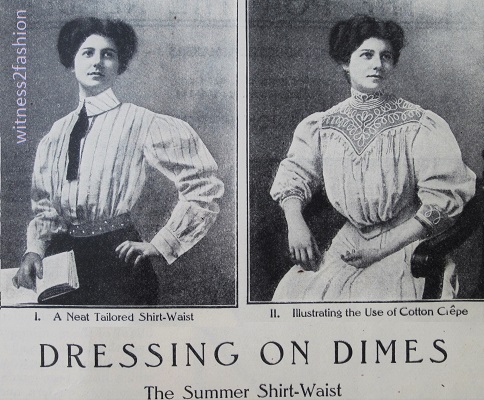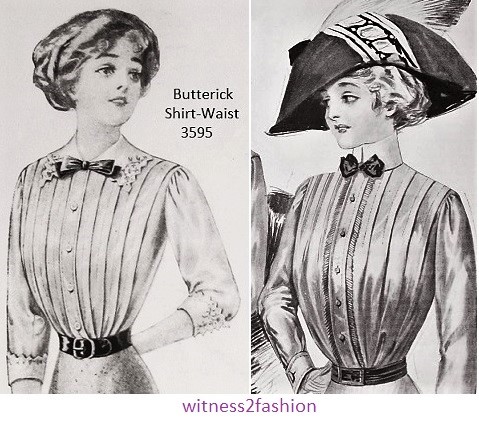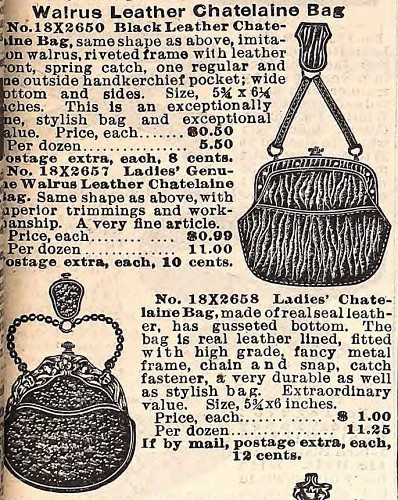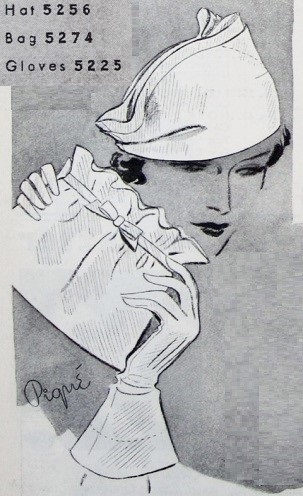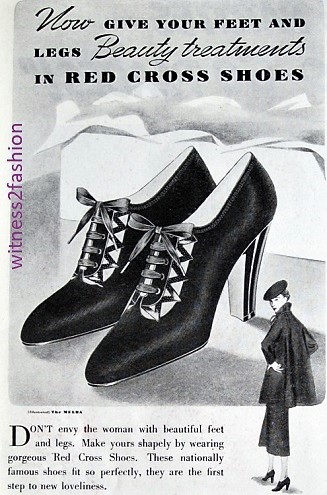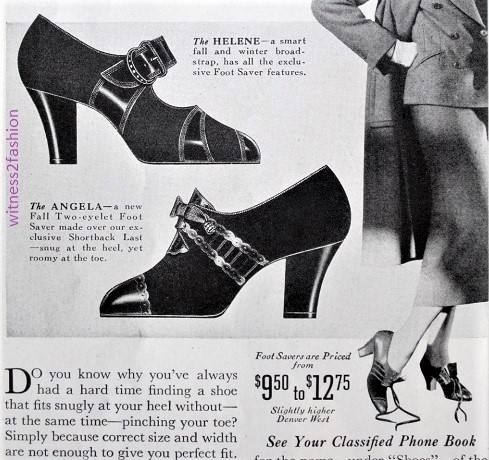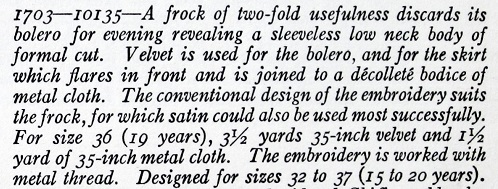Thanks to reader kellycb for wondering about the brands of zippers sold through the Sears, Roebuck catalog. I thought I could do a quick search through the 1930’s Sears catalogs available through Ancestry.com. [All images in this post which are labeled “Sears” are copyrighted by Sears Brands LLC. Please do not copy.]

Zipper brands available from Sears in 1939 included Talon, “Standard”, and Crown. Earlier catalogs also sold Koh-i-noor slide fasteners, snaps, and hook and eye tape.
I was quickly able to find that Sears sold Talon Hookless Slide Fasteners, and “Crown” fasteners — possibly a house brand, since Sears also sold Crown fabrics. But that’s not what soaked up two days of my browsing time. It was the constant use of the word “Zip” to indicate a slide fastener.

Zip: Slide fasteners sold through the Sears catalog, Spring 1935. Sears image via Ancestry.com
Technically, advertisers could not call a slide fastener for a garment a “zipper.” But the American public apparently did refer to them as zippers, so the word “zip” — not copyrighted — appears quite often.
The word “zipper” was owned by the B.F. Goodrich company.

B.F. Goodrich Zipper Ad, December 1928, Delineator magazine
Originally the “Zipper” was a winter overshoe (rain boot) that closed with a slide fastener, made by the B.F. Goodrich rubber company. As I wrote is a previous post, “by 1922 Goodrich had launched their “Mystik Boots,” which closed with Hookless [brand] slide fasteners instead of snaps or buckles. They were such an immediate success that B.F. Goodrich Company asked Hookless for exclusive rights to use their fasteners. In 1923, the Mystik Boot was renamed, to draw attention to the ease with which they were put on and taken off.
“What we need is an action word,” said company president Bertram G. Work, “something that will dramatize the way the thing zips.” He quickly added, “Why not call it the zipper?” – from The Evolution of Useful Things, by Henry Petroski, p. 111.
The word “zip,” indicating speed or energy, was already popular slang.

These 1930 trousers for young men and boys had “zip and dash,” but they did not have what is now called a zipper. The fly closed with buttons. Sears image via Ancestry.com.
You could zip around town in your car or on a bike. “Zip” was also the name of a hair remover that had been in use since the twenties.

Zip hair remover ad from Delineator, November 1924. “Zip — It’s off because it’s out.” “You actually destroy the growth by gently lifting out the roots — painlessly and harmlessly.” [That’s what it says….]
In Akron, Ohio, where Goodrich “Zippers” were manufactured, a college football team is still called the Zips.
The speed with which the name of a trademarked product — the Zipper boot — became the standard American noun meaning “slide fastener” amazed me.
Anyone who is seriously interested in the history of the slide fastener, now usually called a zipper, should know about Robert Friedel’s book, Zipper: An Exploration in Novelty, which has been described brilliantly by The Vintage Traveler. (Click here for her “Currently Reading: Zipper: An Exploration in Novelty“. The Vintage Traveler also showed many ads for zippers in her “Zippers, Part II.”
As Friedel explains, early slide fasteners were put into production and sold before they were perfected [rather like some software today.] One problem with the early slide fasteners was that they worked as long as they remained perfectly straight — but sitting usually causes the fabric in a skirt placket or trouser fly to bend. Twenty years later, people who had been publicly embarrassed by a broken slide fastener were not eager to try the improved versions in their clothes.

A Hookless Fastener is featured on this man’s suede jacket (called a blouse) in the Sears catalog for Fall, 1930. “Zip it’s on — Zip it’s off! — that’s the quick modern way to dress….”
Menswear quickly adopted slide fasteners in sports jackets and work shirts, but resistance to replacing button-fly trousers with zipped flies continued till the late 1930’s.

Sears offered many clutch bag models with zippered compartments, and handbags with concealed zip interior pockets. Fall, 1930. The Hookless Fastener Company was now better known as Talon.
Slide fasteners worked well on straight openings: clutch handbags, mail bags, boots and leggings, even sleeping bags.
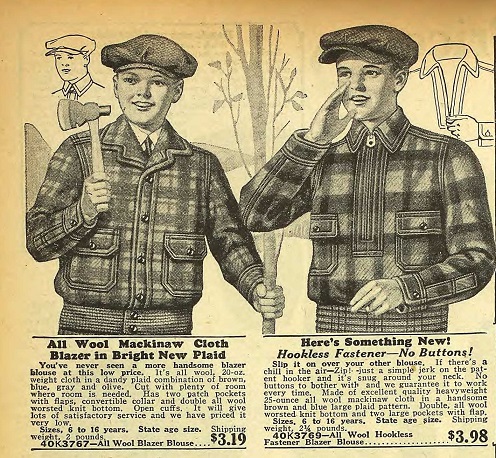
A boy’s jacket from Sears, Fall, 1927, closes with a Hookless slide fastener. “Zip! — just a simple jerk on the patent hooker and it’s snug around your neck. No buttons to bother with and we guarantee it to work every time.” Judging from the need to explain, this really was “Something New” in 1927.
One brilliant approach to selling slide fasteners urged their use in children’s clothing to make children more self-reliant. (See “Zippers Are Good for Your Children.” A bonus: children didn’t remember those embarrassing old zippers!)

“Put in Zips so she can dress herself — Even tiniest tots manage them.” Sears catalog, Spring, 1939.
Regardless of B.F. Goodrich, the word zipper did get used by other sources:

Here, the Sears catalog for Fall, 1929, suggests making children’s winter leggings with a “zipper side fastener.” (Leggings with dozens of buttons must have been a nightmare for Kindergarten teachers.)
These trousers — which did have a zipper fly — were aimed at young men with waists 26 to 32 inches: “College Styles” “for youths.”

Sears offered these trousers “featuring the FLASH Slide Fastener” in Spring of 1935. The extremely wide legs — sometimes called “Oxford bags” — were a young man’s fashion.
Slide fasteners also made an early appearance in girdles and corsets.

“Zip! It’s Open!” The woman on the right is enjoying the ease of a zippered girdle; the woman on the left wears a corselet closed with hook and eye tape. Sears catalog, Spring 1932.
Slide fasteners were used in sports clothing and work clothing before 1936, but they seem to be most often used on relatively heavy fabrics, like leather, wool, corset coutil, and sturdy cottons.

This “Pic-Pon Cord” cotton dress from Sears has a “zip closing;” Sears catalog for Spring, 1935.
Also made from corduroy is this woman’s jacket from 1933.

Zipper neckline closing on a “Sporting Life” jacket for women from Sears, Spring 1933. Its “popular, practical zipper closing” uses a “Jiffy” Fastener.
According to the catalogs, this was Sears’ most popular work dress for women, and in 1935 it was offered in the traditional button front or (“More Style! More Comfort!”) with a zip- closed front.

From the Fall, 1935 Sears catalog: a sturdy work dress. The “new, improved” version with the zipper (right) cost more; zippers were relatively expensive.

The 1935 “Zip-Closed Front” work dress cost twenty cents (20%) more — a zipper cost about 20 cents.
By 1937, the “zip close” version was featured more prominently than the buttoned one.

In Sears’ Spring catalog for 1937, the work dress with a zipper was more prominent.
The zipper made a transition from sports and house dresses to dressier women’s clothing by 1937. Several Paris designers began showing dresses with visible zippers in 1935-36; Schiaparelli put visible plastic zippers right on the front of her dresses. However, I found a Vionnet design from 1929 that had a prominent zipper front closing. It was copied by Butterick as pattern 2526.

A Vionnet ensemble sketched for Delineator magazine in 1929 has a prominent zipper on its front.
Butterick also offered a different dress pattern that was featured in advertisements for the Talon Hookless Fastener in 1928-29.
Here’s a closer look at Sears’ [rather limited] Slide Fastener selection from 1935:

“Zip;” slide fasteners available from the Sears catalog, Spring 1935. Customers were assured that these stayed shut (“locks in any position.”) They were also washable and rustroof — unlike early hookless fasteners which had to be removed before washing your garment.
The concealed “Kover-Zip” slide fastener from Koh-i-noor was available in separating or non-separating versions. Its zipper teeth were completely concealed by a color-fast grosgrain cover. It was a luxury item, more than twice the price of a “Standard slide fastener.” Sears’ Zipper colors were limited to black, brown, tan or white.
In 1935, the zippers were recommended for “finishing sport-wear, blouses [like the man’s suede “blouse” shown above], children’s garments” (the Kover-Zip) or in “sturdy quality for sport coats, sweaters, children’s suits, dresses.” In other words, they were for casual and practical garments, usually made of heavy fabrics.

Men’s shirts with zip fronts; Sears catalog, Fall, 1937.
After the Paris collections of 1935-36, zippers were about to undergo a rapid change for the better. (See “Zip” Part 2, coming soon.)
